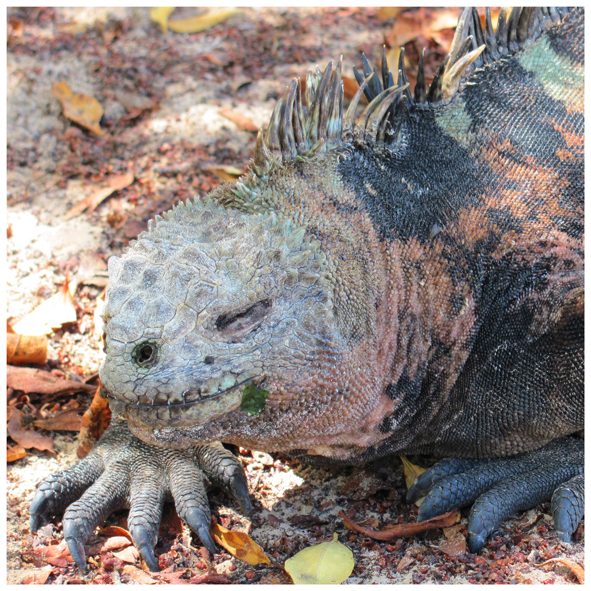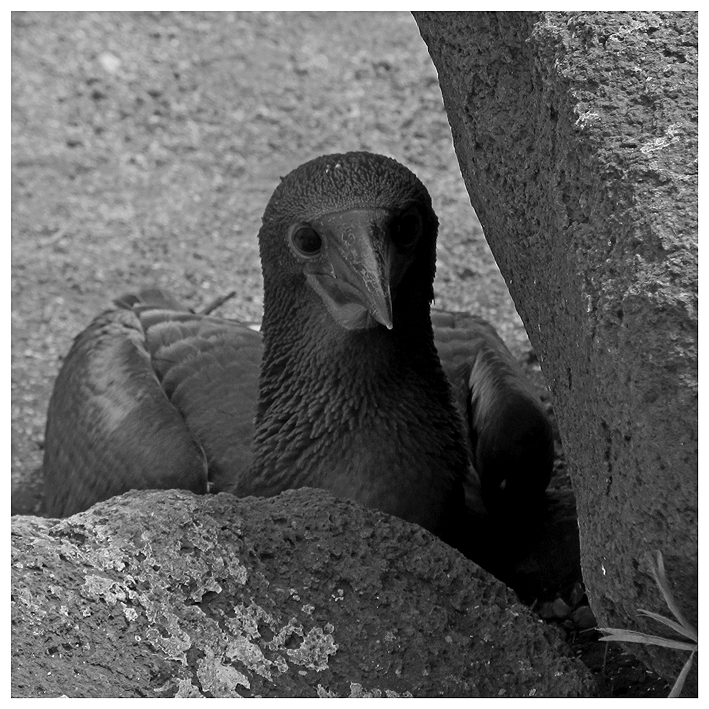Galapagos Islands: the Land of Sir Darwin and Sir George
There is a place on the earth where everything is filled with all possible tones of blue all year round. A month ago I discovered this place — the Galapagos Islands.
White people discovered the Galápagos Islands in 1535 when a Spanish ship came upon them after being blown off course by a storm. The islands were uninhabited, there were no signs of human settlement. The unfortunate ship was supposed to takea Panamanian bishop to Peru without loosing sight of the South American coast. However, when the storm calmed down, the Spaniards found that they had brought the bishop to a sailor’s nightmare where the bits of land were mockeries, with no safe anchorages nor shade nor fresh water nor fruit, nor human beings of any kind.
(Kurt Vonnegut,Galápagos novel).

Without considering financial matters, the Galapagos Islands together with Jamaica and Dominican Republic are pleasant exceptions for Kazakhstani travelers because they have to obtain visa in order to visit all the remaining countries of the Americas, as well as all the neighboring island states. But the Galapagos Islands are a domain of Ecuador, where this wearisome and often costly procedure is not necessary. Once you have arrived in Quito, the capital city of Ecuador, a common seal is attached to your passport indicating your crossing the state border. Upon leaving the country you’ll just have to pay a $40 fee.
The archipelago consists of 13 major volcanic islands, 6 islets and 107 rocks and alluvial territories in the Pacific Ocean 1000 km off the Ecuador coastline. Apart from Sir Charles Darwin’s natural laboratory, which is well known from our school program, there is also one of the most famous natural reserves in the world.
They did not claim the islands for Spain, any more than they would have claimed hell for Spain. And for three full centuries no other nation wished to own the archipelago till changes in the public opinion allowed it to appear on maps. Then, in 1832, one of the smallest and poorest countries on the planet, which was Ecuador, asked the peoples of the world to share this opinion with them: that the islands were part of Ecuador.
The most convenient (and the most affordable) way to get to the islands is to fly from Quito (or the biggest city in the country — Guayaquil) to the smallest Baltra Island. However, in case you are Roman Abramovich, you’d better make use of your own yacht or take one on lease, if you don’t have any available at the moment. I’d like to point out that the prices offered by travel companies for traveling to the islands imply that you are nearly as wealthy as Abramovich.
But if you set yourself a goal, you may have a rather cost effective journey. The main goal is to catch cheap flights, which are most likely to occur off season — from May to January.
During the World War II, a US Air Force Base was built on the island, patrolling the Pacific Ocean in search of enemy submarines and protecting the Panama Canal. When the war ended, the entire property of the base was transferred to the government of Ecuador. Nowadays, this is an Ecuatorean regular Air Force Base. Until 1986 Baltra Airport was the only airport on the archipelago, connecting the islands to the mainland. Now there is another airport on San Cristobal Island, but most of the flights still depart from Baltra Island.

Flights are performed by three air companies, two of them are: TAME and AeroGal. Flights cost about $400, but you have to book tickets at least a month in advance because the Ministry of Tourism of Ecuador applies restrictions to the inflow of passengers to the islands. Prior to boarding those flying to the islands have to go through special luggage inspection. At Baltra Airport you’ll have to pay $100 additionally as a fee for visiting the national park (all the islands on the archipelago are one national park, but excursions are paid for separately). Directly prior to leaving the airport, your luggage goes through the second «control» inspection aimed at determining whether you have brought any fruits or other biological contagion to the island. On such a tiny island, free air companies’ buses transport passengers to the ferry to Santa Cruz Island. The ferry takes 2 minutes to cross the Itabaca Channel. There you’ll get on a regular bus which will transport you to the archipelago’s biggest city.
My arrival at Puerto Ayora coincided with a national football championship match taking place at the local stadium. Because of this, the city seemed to be desolate. But in the evening, cars with joyful fans holing waving flags appeared everywhere. Entertainments of other kind available in Puerto Ayora can be counted on the fingers of one hand. Puerto Ayora, located on Santa Cruz Island, has population of 18 thousand people (while the archipelago’s total population is 30 thousand). The government is interested in preserving this unique natural reserve rather than in increasing tourist inflow to the islands. Thus, the tourism industry is developing very slowly and at least a half of their citizens are unemployed.
What can tourists do? There are bicycle lanes arranged along the streets. You can easily hire a bicycle at any tourist office for $3 per hour. Then you can catch a taxi (taxis on the island are pickup trucks), place the bicycles on the trunk and go to the highest location of the island, Los Gemalos — volcanic craters in wet forests which will cost you $10. And then you can ride downhill for about 2 hours passing cows grazing together with tortoises.
The further and higher you go away from the coast, the softer and more humid is the climate of Santa Cruz Island, meaning that you are entering a tropical zone. The civilization is concentrated mainly along the coast surrounded by dry brushwood, while in the center of the island there are coffee and banana plantations, country cottages and quiet hotels. In the evenings, numerous souvenir shops open in the city where you can find both pennyworth magnets and real design masterpieces and works of art.

The cost of accommodation at hotels depends on the number of stars and remoteness from the coast: from $40 for an ordinary double room to several thousand dollars for apartments at the seaside hotels. If you are going to have a meal you should know that bills in the numerous cafes and restaurants include taxes (15%) and service (10%) which are not indicated in menu.
If you happen to be on an oceanic island, you must taste seafood, fried octopus for example. Though it has a kind of «rubber-like» consistence, it is very tasty. If you take an apartment on lease you can buy fresh fish at the pier, where local fishermen bring their haul every evening, and cook it yourself.
If Charles Darwin had not announced the Galapagos Islands to be a very instructive place, Guayaquil would be fated to remain just one of numerous scorching and dirty seaports and the islands would be of the same value for Ecuador as cinder yards somewhere in Staffordshire… There is only one word to characterize that sudden metamorphosis suffered by the islands, which became pricelessat once after being worthless, the word is — magic.
The best place to start a tour of the island is the Darwin Research Station, where giant tortoises are studied and bred. On the way to the station, in the very center of the city, among mangroves, there are crabs creeping, herons and pelicans walking, and sea-lions basking in the sun at the pier.
During my stay on the islands, the main starting point for tourists was the Christmas Tree — an exotic tree bearing relation to its northern congeners merely due to its Christmas decoration. Then passing by iguanas basking in the sun on the sidewalks, you’ll start to count giant tortoises. The more tortoises you see, the nearer is the station. At the station there live ten really giant tortoises and an innumerable quantity of smaller ones. The 300-year-old Sir Geo, who is the last living tortoise of his species, also lives there.
These are all the island’s noticeable places of interest and, after visiting them, tourists as a rule go to the famous Tortuga Bay — turtle bay and the beach with the same name. At the entry to the path leading to the bay, the national park officers register visitors and instruct them. The path laid with volcanic tuff leads to the Pacific Ocean through thick brushwood, cacti and burrs. Tortuga has two beaches: a large beach located on the coast and small one located in a lovely lagoon. There is nothing to do at the large beach, except for surfing; swimming is for extreme lovers only because waves can easily carry swimmers far into the ocean. Meanwhile, at the small beach you can enjoy plenty of entertainments – kayaking, watching sharks and stingrays, diving or just sunbathing while watching prehistoric iguanas, turtles and flamingoes. But do not forget to use sun-protection cream.
Human beings had much bigger brains back then than they do today, and so they could be beguiled by mysteries. One such mystery in 1986 was how so many creatures which could not swim great distances had reached the Galapagos Islands, an archipelago of volcanic peaks due west of Guayaquil separated from the mainland by one thousand kilometers of very deep and cold water right from the Antarctic. When human beings discovered those islands, there were already geckos and iguanas and rice rats and lava lizards and spiders and ants and beetles and grasshoppers and mites and ticks in residence, not to mention enormous land tortoises.

What form of transportation had they used?
The most common type of leisure activities on the Galapagos Islands is cruising from one island to another. Cruises generally last for about a week. However you can do with a one-day tour to Seymour Island, located north of Baltra ($100 per person). A motor boat with an English speaking guide will carry you to another corner with virgin nature, colonies of seabirds, sea-lions and iguanas. Birds and animals are not afraid of people but you are not allowed to come near them and especially to touch them because they are very sensitive to human smells, including tobacco smoke. That is why smoking and eating is prohibited on the island. There are lots of gad-flies there, which represent an element of biological cycle: gad-flies bite sea-lions, small birds eat gad-flies. They also like tourists very much, that is why a diethylphthalate based repellent will be very useful.
Apart from the main island tour, the program includes snorkeling (swimming in open water while equipped with mask and flippers together with sea-lions, tropical fishes, stingrays and even sharks sometimes), going to the beach and having dinner. But while sharks do not pose a threat, the cold Pacific Ocean requires wearing a wetsuit.
While the Island of Seymour is attractive firstly due to its wildlife, the Island of Bartolome, located east of the Island of Santiago, attracts by its sceneries. During the excursion you will be told how the Galapagos archipelago appeared as a result of volcanic activity, as well as what the differences between lava and magma are. This island named after David Bartolomeo, who was lieutenant of the British naval forces, is the most interesting to visit. It’s scenery was used in 2003 as perfect backdrop for the film Master and Commander: The Far Side of the World, starring Russell Crowe. As a matter of fact the island is just a dead volcano and has a range of volcanic formations of different colours, including a cone-like hill consisting of tuff and called Pinnacle Rock.
If one volcano-island is not enough, you can also go to the largest island of the archipelago, Isabela (named in honor of Queen Isabela who sponsored Christopher Columbus’s travel). Its highest point is Wolf Volcano with an altitude of 1,707 meters above sea level. You can get up there by horse. The shape of the island resembles a sea-horse. It consists of six volcanoes which merged once and formed a single land mass. From Santa Cruz Island and Puerto Ayora you can get to the third most populated city, Puerto Villamil, located in the south eastern part of Isabela Island, which will cost you $40. Most of the tourists who come to the archipelago are from the USA, Europe Australia and South Africa. According to statistical data, up to one million tourists visit Ecuador annually, while the country’s population is 13 million.
Of course Ecuador does not consist merely of the Galapagos Islands. You’ll be able to keep yourself busy in the mainland for at least two weeks. There are many places of interest such as cities with historical architecture, mountain peaks and volcanoes, Indian tribes and the Amazonian jungle. And of course, there is no tourist who can deny himself the pleasure of walking over the equator — the more so the country is named after it. The most helpful thing will be basic knowledge of the Spanish language which is spoken there generally. In such a case, you expenses will automatically decrease and you will not need use the services of guides and tourist companies — local people will help you in any matters despite the ever-increasing number of tourists.